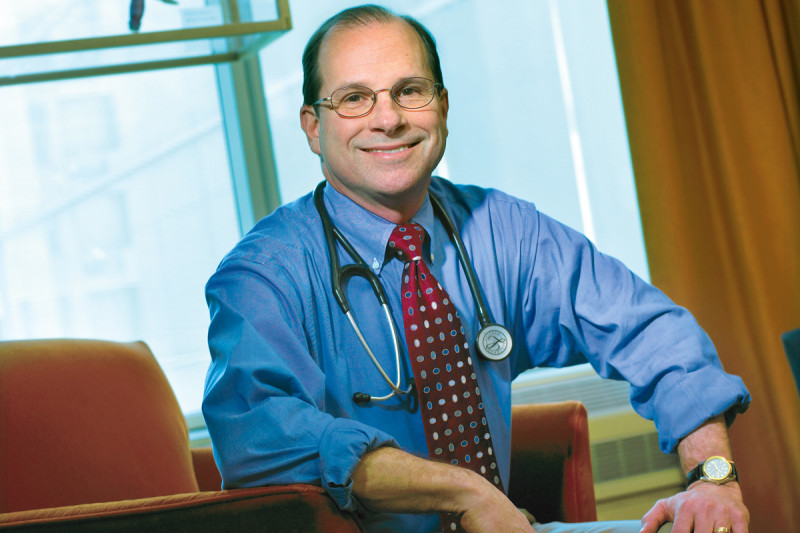
Kevin Oeffinger
After I graduated from college, I started working on a PhD in neurophysiology. But I realized that my personality was not suited to being in the lab full time — I needed more “people” contact. So I decided to go to medical school.
I chose family medicine as my specialty. I was attracted to the variety of ages and health problems of my patients and the opportunity to get to know them over a long period of time — these were not one- or two-visit relationships. These same things drew me to providing care to survivors of pediatric cancer — an area in which there was a real need for healthcare and research.
For more than 15 years, pediatric endocrinologist Charles Sklar has directed Memorial Sloan Kettering’s Long-Term Follow-Up Program, which provides care for and studies the health outcomes of survivors of pediatric cancers. As this population grew older, Memorial Sloan Kettering recognized that there was a need for an extension of the program to care for them as adults.
I was at the University of Texas Southwestern Medical Center in Dallas and directed a program for young adult survivors of pediatric cancer there when I was recruited by Richard O’Reilly, Chair of Memorial Sloan Kettering’s Department of Pediatrics, to develop a similar program here at Memorial Sloan Kettering.
Dr. Sklar and I have collaborated for several years in studies through the Childhood Cancer Survivor Study (CCSS), a multi-institutional project supported by the National Cancer Institute (NCI) that tracks the health outcomes of pediatric cancer survivors diagnosed between 1970 and 1986. Through this study we have learned that almost three-fourths of pediatric cancer survivors will develop a chronic health problem within 30 years of their cancer diagnosis. This may include heart disease, second cancers, and hormonal disturbances.
As pediatric cancer survivors get older, most do not continue to be followed at the institutions where they received treatment. In fact, less than 20 percent of long-term survivors in the US are still being followed at a cancer center. At the same time as these survivors are becoming “lost to follow-up,” they are entering the years in which they are at the highest risk for several of the serious problems — such as breast cancer or heart disease — caused by the previous cancer therapy, yet are not being followed by a clinician familiar with their health risks. So what we’re doing here with the Long-Term Follow-Up and Adult Survivor programs is the exception rather than the rule.
We have a threefold mission. First, we provide quality risk-based care though our clinical program. When we see a new patient, we develop a plan for screening, surveillance, and prevention that takes into account risks based on the cancer for which a patient was treated, what therapies were used, genetic predispositions, lifestyle behaviors, and any other health conditions he or she may have. Then we see each patient every 6 to 12 months to monitor his or her health. Our clinical team includes two nurse practitioners, a social worker, and a psychologist.
Second, we investigate the healthcare needs and problems of pediatric cancer survivors. We do that through our research here and collaboratively through the CCSS and the Children’s Oncology Group, a 240-institution clinical trials consortium that is supported by the NCI.
For example, we currently have a study that is assessing cardiovascular risk in adult survivors of childhood leukemia. In addition, we are studying ways to increase the rate of breast cancer screening in women who have had chest radiation for the treatment of Hodgkin’s disease. This is particularly important because about one of five women treated with chest radiation during their childhood or adolescent years will be diagnosed with breast cancer by the time she is 45.
In another study for which Dr. Sklar and I recently received funding, we will work with the Memorial Sloan Kettering pediatric and adult bone marrow transplant services to explore why women who have been treated for leukemia with total body irradiation and a bone marrow transplant often develop diabetes or cholesterol problems.
Finally, we’re working to improve the delivery of information about this population to healthcare professionals nationally and to educate survivors about their risks.
The most personally rewarding part of what I do is the face-to-face contact I have with young men and women who have survived treatment for childhood cancer and who understand that although they may face health problems there are ways we can work together to reduce the seriousness of some of these problems — for example, identifying heart disease before someone has a heart attack or diagnosing breast cancer early.
It is also very gratifying to work in a world-class cancer center with oncologists and other cancer specialists who are at the top of their fields. We all have the same goal — to cure cancer while maximizing the health of the survivor.